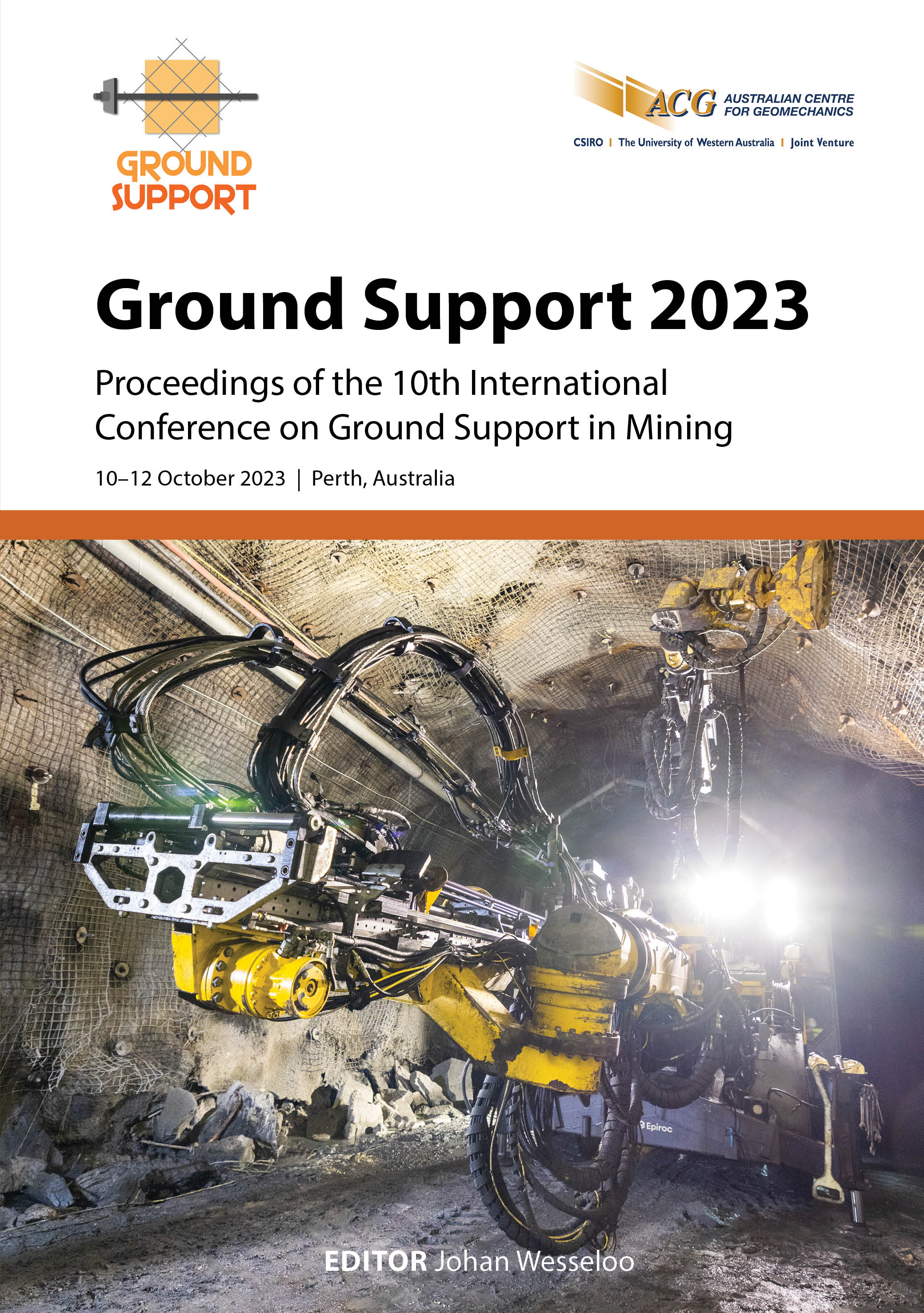Ground support methods for vertical development

|
Authors: Scott, CG; Sidea, D; Masters, SJ |
DOI https://doi.org/10.36487/ACG_repo/2325_23
Cite As:
Scott, CG, Sidea, D & Masters, SJ 2023, 'Ground support methods for vertical development', in J Wesseloo (ed.), Ground Support 2023: Proceedings of the 10th International Conference on Ground Support in Mining, Australian Centre for Geomechanics, Perth, pp. 345-358, https://doi.org/10.36487/ACG_repo/2325_23
Abstract:
Vertical development is an integral part of underground mining. At a minimum, underground operations require vertical development for ventilation and secondary means of egress; many deep mines also require haulage shafts for material extraction. Vertical development can be excavated by various methods with raiseboring becoming one of the most common methods in Australian underground operations due to its speed, efficiency and safety. Other excavation methods for vertical development include blind boring, blind sinking, strip-and-line and vertical shaft sinking machine (VSM). Access for the installation of ground support varies depending on the excavation method. Vertical development is often required to be functional over many years (20+). Once commissioned, it is often difficult or impossible to re-access shafts for rehabilitation support. The decision to support and the type of support, if required, can be critical to the shaft’s operational success. The decision to support may be based on the performance requirement of the shaft, availability of access and anticipated stability issues. Stability issues ranging from near-surface weathered material, isolated poorer zones in more favourable rock masses and competent rock/high stress to base of shaft geometry are considered in this paper. An individual shaft may have several areas that require support and may require different assessment approaches. In this paper, three main zones of vertical development are considered for stability and support design; the collar (near-surface poorer quality weathered zone/soils if excavated from surface), broken zones/poor ground conditions and the base of the shaft development. Many methods of assessing shaft behaviour and support requirements exist. This paper discusses typical shaft ground support types and selected methods of stability and support assessment, types of support, loading conditions and examples for various excavation methods/ground conditions.
Keywords: ground support, vertical development, shafts
References:
Auld, FA 1979, ‘Design of concrete shaft linings’, Proceedings of the Institution of Civil Engineers, vol. 67, no. 2, pp. 817–832.
Barton, N, Lien, R & Lunde, J 1974, ‘Engineering classification of rock masses for the design of tunnel support’, Rock Mechanics, vol. 6, no. 4, pp. 189–236.
Bieniawski, ZT 1989, Engineering Rock Mass Classification, Wiley, Hoboken.
Cheng, YM, & Hu, YY 2005, ‘Active earth pressure on circular shaft lining obtained by simplified slip line solution with general tangential stress coefficient’, Chinese Journal of Geotechnical Engineering, vol. 27, no. 1, pp. 110–111.
Coombes, BM, Lee, MF & Peck, WA 2011, ‘Improving raisebore stability assessments and risk’, Proceedings of the 2011 Canadian Institute of Mining, Metallurgy and Petroleum Conference and Exhibition, Canadian Institute of Mining, Metallurgy and Petroleum, Westmount.
Edelbro, C, Brummer, R, Pierce, M, Sandstrom, D & Sjoberg, J 2019, ‘Raiseboring in difficult rock conditions’, in J Hadjigeorgiou
& M Hudyma (eds), Ground Support 2019: Proceedings of the Ninth International Symposium on Ground Support in Mining and Underground Construction, Australian Centre for Geomechanics, Perth, pp. 185–198,
/1925_11_Edelbro
Grimstad, E & Barton, N 1993, ‘Updating of the Q-System for NMT’, Proceedings of the International Symposium on Sprayed Concrete, Norwegian Concrete Association, Oslo, pp. 46–66.
Hoek, E, Kaiser, PK & Bawden, WF 1995, Support of Underground Excavations in Hard Rock, A.A. Balkema, Rotterdam
Hoek, E & Marinos, P 2000, ‘Predicting tunnel squeezing’, Tunnels and Tunnelling International. Part 1 – November 2000.
Hutchinson, DM 1996, Handbook on Liner Design for Drilled Ventilation and Access Shafts.
Ito, T & Matsui, T 1975, ‘Methods to estimate lateral force acting on stabilizing piles’, Soils and Foundations, vol. 15, no. 4.
Lame, G 1852, Lecons sur la Theorie de l Elasticite, Gauthier-Villars, Paris.
Marlow, P, Webber, S, Mikula, PA & Lee, M 2013, ‘Bored reinforced piles for raisebore support: four case studies, and guidelines developed from lessons learnt’, Mining Technology, vol. 122, no. 3, pp. 159–165.
Martin, CD, Kaiser, PK & McCreath, DR, 1999, ‘Hoek-Brown parameters for predicting the depth of brittle failure around tunnels’, Canadian Geotechnical Journal, vol. 36, no. 1, pp. 136–151.
Palmstrom, A 2000, ‘Block size and block size distribution’, paper presented at GeoEng 2000, Melbourne.
Schach, R, Garshot, K & Heltzen, AM 1979, Rock Bolting – A Practical Handbook, Pergamon Press, New York.
Seedsman, RW 2022, ‘Options for designing a hold-retain strategy for excavations in stratified rock’, in RE Hammah, TE Yacoub,
A McQuillan & J Curran (eds), The Evolution of Geotech – 25 Years of Innovation, Routledge, Milton Park, pp. 569–575.
Standards Australia 2002, Structural Design Actions, Part 0: General Practices (AS1170), Standards Australia, Sydney.
Standards Australia 2010, Pressure Vessels (AS1210-2010), Standards Australia, Sydney.
Standards Australia 2018, Concrete Structures (AS3600), Standards Australia, Sydney.
Standards Australia 2020, Steel Structures (AS4100), Standards Australia, Sydney.
Wong, RCK & Kaiser, PK 1988, ‘Design and performance evaluation of vertical shaft: rational shaft design method and verification of design method’, Canadian Geotechnical Journal, vol. 25, pp. 320–337.
© Copyright 2025, Australian Centre for Geomechanics (ACG), The University of Western Australia. All rights reserved.
View copyright/legal information
Please direct any queries or error reports to repository-acg@uwa.edu.au
View copyright/legal information
Please direct any queries or error reports to repository-acg@uwa.edu.au
